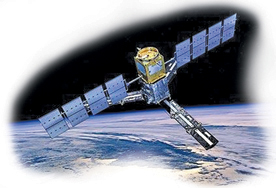California Agricultural Technology Institute
Satellites set to help with irrigation
Fresno State, NASA research teams seeking to correlate near-infrared images to crop performance, water needs
Irrigation research specialists from Fresno State s Center for Irrigation Technology (CIT) are looking to eye-in-the-sky technology to help improve irrigation efficiency for farmers and crop managers in California s Central Valley.

Florence Cassel Sharma, CIT soil scientist, is leading a study of new methods to integrate satellite imagery and surface observations of plant and soil moisture status to provide near-real-time information of crop water use over vast geographical areas.
The work includes partnerships with scientists from CSU Monterey Bay, the National Aeronautics and Space Administration (NASA), the United States Department of Agriculture (USDA), UC Davis, and the California Department of Water Resources (DWR).
The DWR currently provides extensive crop water use information to growers through its California Irrigation Management Information System (CIMIS), Cassel Sharma noted. However, such information cannot always be extrapolated to all cropping and irrigation systems. That s where satellite technology comes in.
The key to this project is to link satellite and ground-truth information, Cassel Sharma said.
Remote sensing, especially in the visible and near-infrared domains, offers an inherently efficient way to observe crop development and generate critical crop parameters over large areas with reasonable spatial resolution, she said. In this project, ground-truth data will help validate satellite data. Ultimately, our goal is to give farmers and water managers access to crop and irrigation information at the field scale through a cell phone for example.
As part of the project, the Fresno State team, that also includes CIT irrigation scientist Diganta Adhikari and assistant plant science Professor Dave Goorahoo, are monitoring crop water use at specific locations using lysimeters, special inground soil container recording devices that relate crop evapotranspiration (ET) to weight changes during a 24-hour period. The data obtained from the lysimeters, as well as other sources such as surface renewal stations, will be compared with satellite imagery, providing a means for correlating and truthing the satellite information.
Once correlative data is established, growers will be able to rely almost exclusively on satellite imagery.
Coinvestigators from CSU Monterey Bay and NASA are leading the processing of satellite images and development of a decision support system to estimate daily crop water use, project crop demand based on historical ET averages or weather forecasts, and produce maps and tables for a chosen time period.
This system would likely be more accurate and simple to use than current methods available to growers, especially for crops grown under specific conditions, Cassel Sharma said.
Project experiments, along with data collection and analysis, are scheduled for three years. Partial funding for this work is being provided by the California State University Agricultural Research Institute (ARI), based at Fresno State. For additional information, contact Cassel Sharma at fcasselss@csufresno.edu.
Back